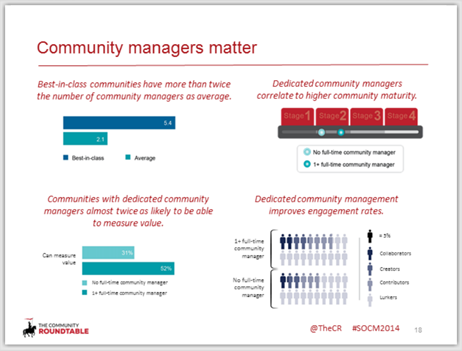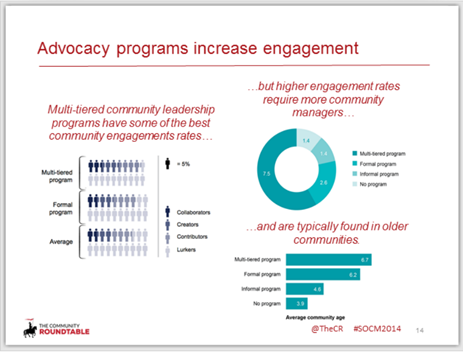Insights from Community Management Research

While every
online community is different, there are specific trends and characteristics
that separate the best from the rest. To help us better understand “How Real-World Community Managers Build
Successful and Thriving Online Communities,” DNN turned to Rachel
Happe (@rhappe),
co-founder of the Community Roundtable (@TheCR), which supports business leaders
developing their community and social business strategies.
In an hour-long
webinar, Happe provided a closer look at the
State of
Community Management in 2014.
The fifth edition of the Community Roundtable’s annual research
surveyed 164 communities across industry,
use case, size and age. Happe helped us understand how communities perform, the
standards and strength of online communities today, and the opportunities that
community managers should focus on to grow their programs.
Let’s have a
look at the topics covered during the webinar.
How Communities Perform
More
organizations are applying more processes to their community management and are
seeing results! Of those with the most mature processes, 85% of the
best-in-class (the top 20%) can
measure
the value of their processes, compared to 48% of the average community.
Community Managers Matter

Best-in-class
communities have more than
twice the
number of community managers
as average. In fact, having a dedicated
community manager correlated to higher community maturity. In other words, the
older your community is, the more likely you are to have a community manager
dedicated to overseeing it. Additionally, communities with dedicated community
managers are almost
twice as likely to
be able to measure value.
Internal and External Communities are Similar, But Different
While behavior
changes may be more complex for internal communities than external communities,
external communities have a
bigger gap
between ambition (strategy) and execution (roadmap). Still both types of
communities are almost equally able to measure value. Engagement rates in
internal communities are higher than in external communities, but not as much
as expected.
Standards and Strengths
Executive
participation is necessary to enable the success of most company engagement, so
it’s not surprising that it is also strongly linked to community engagement.
This validates the need for both sponsorship and behavior modeling on the part
of executives.

23 Benefits of Online Support Communities (That You Never Considered)
By Dennis Shiao
Strategy, Policy and Governance Remain Strong
When it comes to
community maturity, a majority of communities have
approved strategies and policies in place. While executives have
helped to facilitate community vision, many struggle to invest fully in them.
As a result, the gap between approved community strategies and funded roadmaps
is significant.
Within
best-in-class communities, 58% include CEO participation (vs. 36% in average
community) and have demonstrated an ability to measure value; in addition,
best-in-class communities have a fully-funded roadmap and advanced community
leadership programs.
Community Programming Is Improving

Community
programming standards are emerging and becoming increasingly integrated within
communities. Best-in-class communities are more than twice as likely to have
integrated editorial calendars.
Additionally, communities that regularly employ content programming, as opposed
to those that occasionally use it, are more likely to perform better.
Mary Cauwels,
DNN’s Senior Director of Product Marketing, shared a
case study of SchoolDude,
a market leader in education enterprise asset management. SchoolDude deployed
an online community on their website using DNN’s
Evoq Social.
Cauwels
described how the user-generated content in SchoolDude’s online community
created relevant and keyword-rich content that’s indexed by search engines
within hours. For Search Engine Optimization (SEO), Cauwels noted this this
content is “the gift that keeps on giving.”
Read DNN's SchoolDude case study:
Opportunities for Growth

Community
managers are
stretched thin, taking
on responsibilities that include curating and sharing content, measuring and
reporting, and promoting productive behaviors. In order to be most effective,
community managers need to understand community value so they can show how
their communities are making an impact.
Establish a Baseline of Metrics

Almost 60% of
community managers report on community metrics on a monthly basis, while
tracking basic activities such as the number of active members and the volume
of new content. However, best-in-class communities are more likely to track
specific outcomes, including volume of comments, questions answered and new
member activity.
Cauwels suggested
that community managers use analytics to garner “internal bragging metrics” to
share with peers and executives. In addition, Cauwels highlighted the
analytics capabilities in DNN’s
online community solution,
Evoq Social.
Advocacy Programs Increase Engagement

Community
advocacy and leadership programs require a strong investment in community
management resources to scale from informal programs to structured programs to
multi-tiered initiatives. Best-in-class communities have significantly more
engagement and have high levels of formal and multi-tiered leadership programs
that deliver some of the best community engagement rates. Of course, with
higher engagement rates comes a need for more community managers.
Recommendations

Individually,
these insights serve to illustrate what successful communities do and how they
do it. Taken together, however, they effectively identify key trends
highlighted in the State of Community Management 2014:
-
Community
management maturity delivers business value
- Executive
participation impacts success
- Advocacy
programs increase engagement
As a result,
investing in community maturity, developing advocacy programs and encouraging
executive participation are key elements in building a
successful and thriving online community. Happe encourages
comparing your own performance against those featured in the report, as well as
seeking resources outside your organization that can help you reach the next
stage in the community development process.
Ultimately, what
helps build better online communities is
learning
from others. By analyzing the characteristics and behaviors of other
communities, community managers can identify the attributes and characteristics
that can help them better understand their community’s value.
Webinar Slides
Feel free to view the slides from DNN's community management webinar.